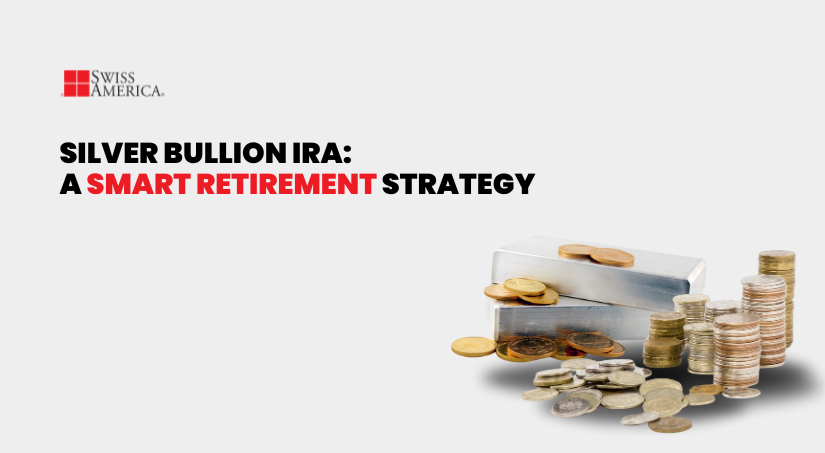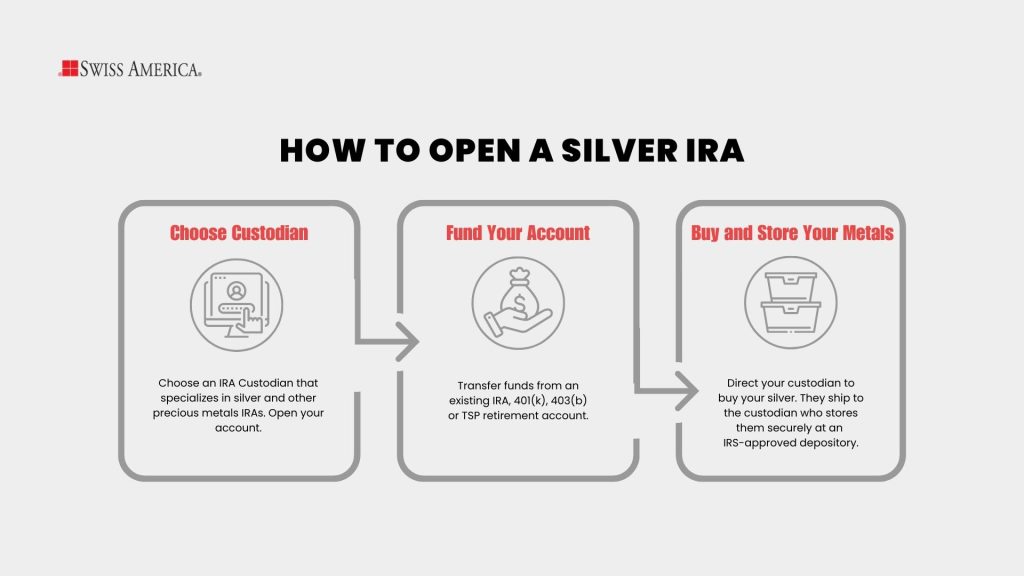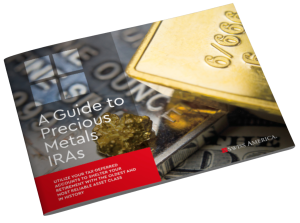
A Silver Bullion IRA is a great way to add physical assets to your retirement savings. Wondering how silver can help protect your wealth and bring stability during uncertain times?
Many investors choose to diversify their savings with physical precious metals for their reliability and potential long-term value. A Silver IRA gives you those rewards plus the tax benefits of a retirement account, making it a good option for protecting your financial future.
In this article, we’ll walk you through the key aspects of Silver IRAs and how they can boost your retirement plan.
Introduction to a Silver IRA
A Silver IRA is a retirement account that lets you invest in physical silver bars and coins, instead of traditional assets like stocks and mutual funds.
You might hear people call these accounts silver IRAs, precious metals IRAs, or Gold IRAs. They all mean the same thing because they allow you to invest in physical metal assets rather than traditional stocks and bonds.
People value silver because it’s a tangible asset and a store of wealth. It’s an interesting metal because we only have so much of it on the earth, and it has strong demand from industrial applications, which helps drive up the price.
Types of silver products eligible for IRA
You can buy coins or bars with your individual retirement account as long as the products meet IRS rules for purity and production standards.
Coins
Silver coins qualify if they are at least 99.9% pure. The IRS requires that they come from approved mints, are official currency, and are in perfect, unused condition.
Bars
Bars also need to be 99.9% pure. They come in various sizes, from as small as 1/6 ounce to as large as 68 pounds. Look for reputable refiners like PAMP Suisse or Johnson Matthey.
Setting up a Silver IRA
You can set up a Silver IRA in just a few steps:
Step 1: Choose an IRA custodian
Start by choosing a custodian and open a self-directed IRA. Just like traditional IRA administrators, a precious metals custodian manages your overall account. Their role is to buy and sell metals on your behalf, take care of storage, and handle IRS reporting.
Custodians charge for managing your account with costs like setup fees and storage fees. It pays to look at several options and compare pricing to make the best choice for your retirement portfolio.
Step 2: Fund your account
You can fund your Silver IRA by transferring funds from an existing retirement account, like a 401(k), 403(b) or TSP.
You can also convert an existing IRA or start a new one by making a direct contribution.
Step 3: Buy and store your metals
Work with a precious metals dealer to decide on which silver and other precious metals you want to buy. Once you make a decision, your self-directed IRA custodian buys the metals on your behalf.
Your metals then ship directly to your custodian’s chosen third-party depository for secure storage.

Investment strategies for Silver IRA
There’s a few different strategies to consider for investing in Silver IRAs:
Long-term holding
Some investors decide to buy silver and hold it for years. This metal can do well during inflation or economic uncertainty, which is a great option for long-term growth. This strategy works best if you’re patient and can handle short-term market ups and downs.
Dollar-cost averaging
If you’re worried about when the best time to buy is, you can use dollar-cost averaging. This investment strategy involves buying a certain amount of silver at regular intervals, regardless of the price.
The benefit of this approach is that it spreads your investment over time and reduces the risk of large swings in silver prices.
Time your purchases
Another approach is to buy silver when prices are low or when there are strong market conditions, like during economic downturns. This strategy requires more effort because you’ll need to watch the market closely to determine whether it’s a good time to buy.
Diversify with other metals
Adding a mix of metals like gold, platinum, and palladium to your retirement portfolio can reduce risk. This is because each physical precious metal reacts differently to market changes. For example, gold is more of a stable asset while silver can give you higher returns but can be more volatile.
Benefits and risks of investing in silver
Just like any other investment, you should be aware of the pros and cons before making a decision. The benefits and risks of Silver IRAs include:
Benefits
Affordability: Silver costs less than gold, so it’s easier for investors to add to their portfolios. As of this writing, gold is $3,800 per ounce, and silver is $47+ per ounce…. so you can buy roughly 81 times more silver than gold.
Hedge against inflation: Just like gold, silver can be a hedge against inflation and currency devaluation. It’s a tangible asset that holds its value because it’s scarce and sees industrial demand. This is different from paper currency, which governments can print whenever they want.
Industrial demand: Silver is a key component in industries like electronics, solar energy, and medical devices. It’s also a limited resource that currently has a deficit, so demand from these industries can increase the overall value of your retirement savings.
Risks
No income: Silver doesn’t generate income or create cash flow. Most investors are OK with this because they invest in a silver IRA as “insurance” to protect their retirement accounts, not necessarily to generate a return.
Storage and fees: Since the IRS requires your custodian to store your gold in a depository, you’ll have storage and other costs to consider.
Tax implications and capital gains
Tax rules depend on if you have a traditional or Roth IRA for your precious metals IRA:
Traditional IRA: With traditional IRAs, you add pre-tax money, and your IRA funds grow tax-deferred. This reduces your taxable income while you’re working.
Then, you’ll pay taxes when you withdraw from the account in retirement at age 59.5. Investors use this type of account if they think they’ll be in a lower tax bracket when it’s time to retire. You’ll also have required minimum distributions once you turn 73.
Roth IRA: You fund this IRA type with after-tax dollars and as long as you’ve held the account for five years, your withdrawals are tax-free in retirement. Roth IRAs do not have required minimum distributions.
Comparing Silver IRA to other precious metals IRAs
How do silver IRAs compare to other precious metal IRAs?
Silver vs. gold
Silver is cheaper than gold, so you can buy more with the same amount of money. This is great for smaller budgets or those who want more metal. Silver can also offer bigger returns, especially during strong industrial demand or economic uncertainty.
Gold is a more stable asset and it’s the precious metal central banks turn to when they want to add security to their treasureries. Some investors use the gold to silver price ratio as a way to buy silver and trade for gold over time.
Silver vs. platinum
Silver has broader uses in industries like electronics, solar energy, and medicine, which can raise demand and push up prices. Silver has more trading volume which as of this writing is 1.56 more times than platinum.
Platinum is a rarer metal and can have higher price increases. It’s a more expensive metal, and the current platinum-to-silver ratio is around 30.
Silver IRA vs. Other metals IRA
| Category | Silver | Gold | Platinum |
| Cost | Lower cost per ounce | Higher cost per ounce | Higher cost, but less expensive than gold |
| Accessibility | Affordable for smaller budget | Requires larger investment | Limited accessibility due to rarity |
| Industrial demand | Strong demand in electronics, solar energy and medicine | Limited industrial use | High demand in automotive and industrial sectors |
| Prive volatiltiy | Higher price volatility | More stable pricing | More volatility with potential for sharp increases |
| Trading volume | 1.56x higher than platinum (as per CME data) | Moderate trading volume | Lower trading volume |
| Rarity | More abundant | Moderate rarity | Rarest of the three metals |
| Return potential | Higher returns during industrial demand cycles | Stable long-term returns | Price increase during supply constraints |
| Economic stability | Benefits during industrial blooms and uncertainty | Central banks rely on gold for stability | Gains value with economic shifts |
Swiss America for your Silver IRA
At Swiss America, we simplify the process of investing in silver through an IRA. With over 40 years of experience as a precious metals dealer, we have earned the trust of thousands of investors. We provide resources like detailed guides, informative podcasts, and the latest market updates to help you make investment decisions.
You can count on our clear pricing, reliable advice, and personalized approach to building a secure portfolio for your retirement.
Silver in your IRA final thoughts
A Silver IRA can add stability to your retirement plan by holding a physical asset and the tax perks of an IRA. It can help protect your wealth from inflation and market changes while also providing the chance for long-term growth.
Before investing, check out our guides to help you research options and talk to a financial advisor to determine if they match your retirement goals and financial needs.
To learn more about securing your retirement, check out our free Gold IRA kit which gives you all the details on precious metals IRAs.
Silver Bullion IRA: FAQs
Is a silver IRA a good investment?
A silver IRA can be a good option if you want to diversify your portfolio and protect against inflation or market volatility. Its value holds up during economic downturns, but like any investment, it carries risks and should fit your overall financial goals.
How does IRA silver work?
Silver IRA allows you to invest in physical silver bars and coins through a self-directed IRA account. Your custodian stores your metals in an approved depository, and you benefit from the same tax advantages as a traditional or Roth IRA.
What does IRA-approved silver mean?
IRA-approved silver means that the bars and coins you buy meet the IRS’s standards for purity and certified manufacturers. Rare or collectible coins and jewelry do not qualify.
Note: The information in this post is for informational purposes only and should not be considered tax or legal advice. Please consult with your own tax professionals before making any decisions or taking action based on this information.
